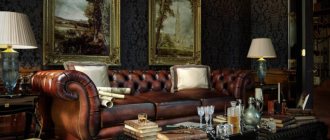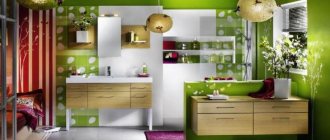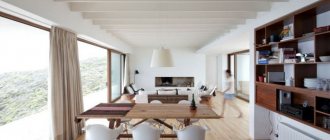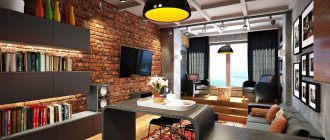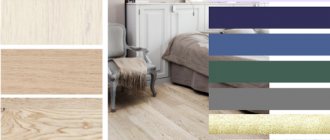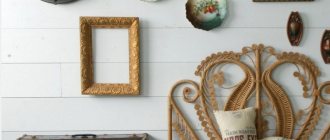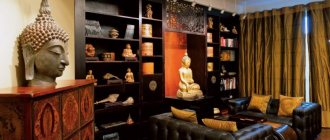A style that differs quite a bit from Baroque, moreover, it is elegant and contradictory, executed in absolute severity - this is classicism in the interior! As a rule, fairly wealthy individuals, as well as those with a high social status, decorate their own homes in this style. The application of exotic patterns, flashy and loud colors, and non-standard accessories is completely unacceptable here.
Features of classicism style in the interior
Interior colors, which mostly use brown and white tones, black and beige, can also be yellow, blue, and red. Interior decor is created using gilded finishing.
The walls are made smooth, painted in one color, without any decorations. It is acceptable to decorate the walls with expensive fabrics.
The ceiling is decorated with plaster and stucco. It can be made with a slight hint of the Ancient era.
The floors are covered with parquet made from valuable wood.
They also choose expensive furniture; the upholstery should be of very high quality. Very popular furniture with original carvings and gilding.
Lighting is thought out very carefully and designed in an original way.
Decoration elements - it is better to choose the most exclusive and unique ones.
Classicism, Empire and Baroque: how are these styles related?
Why is it worth raising the topic of using Baroque and Empire styles if we are talking about classicism? Everything is simple and understandable. Let's figure it out.
Classicism and Empire style
The interiors of classicism and empire style are inextricably linked. More precisely, the Empire style is classicism in an improved form, that is, it is a style at a high stage of development of the latter. Its homeland is France. The impetus for its inception was the successful campaigns of Napoleon, which could not but affect all spheres of social life at that time.
What is the difference between Empire style and classicism? From the point of view of interior design, the answer is very difficult to give. After all, the modification of style occurred under the influence of military-political processes, which could not but leave its mark.
- It is worth noting that the Empire style has similar features to the Baroque, which stood on the other side of classicism. It is characterized by greater idleness and solemnity.
- The colors in the interior became brighter, more saturated, and the inherent calm and tranquility of classicism disappeared.
- Depictions of military achievements and other images that enhance patriotism have become commonplace.
It is quite possible to repeat the Empire style in a modern interior. Moreover, the severity of the edges is somewhat erased. More complicated and casual decor, brighter and more catchy shades are allowed. At the same time, it is necessary to preserve the inherent symmetry and conciseness of classicism.
Classicism and Baroque
Classicism and Baroque in the interior are two opposing styles. Moderate, calm, monumental classicism initially could not get along with the pompous, overly bright and idle baroque.
- It is not for nothing that the style received such a name, because in translation it means “pearl of a bizarre shape.”
- It is characterized by: picturesqueness, dynamism, a large amount of decor, stucco. In a word, this is a style of pronounced luxury.
- However, despite this, styles can even be combined and combined. This applies specifically to modern designs.
- After all, with a professional approach, you can be able to combine even incompatible things, while obtaining a brilliant result.
- Some merging of styles has been observed since the dawn of their emergence. This applies to the version of French classicism that we mentioned above.
- An interior in a classic style will always be relevant. It has not lost its popularity for centuries and is only strengthening its position. This design will be relevant when decorating houses, apartments and even offices, in order to emphasize established success and stability.
- Classicism in the interior of an apartment, especially a small one, will be more difficult to implement. But if the ceiling height is very small, it is better to abandon this idea altogether. The fact is that the inherent monumentality of the style is difficult to convey in a very limited space. However, this problem can be partially corrected: add modern classicism.
- The best composition for such an interior is radial or centric. This means that all objects seem to be connected to each other in a chain connection, as if flowing.
- Do not forget about the above-mentioned technique: build niches, cabinets, blocks with a retractable mechanism. All this can be decorated, and thus skillfully hide objects that are unwanted to the eye.
- In order to emphasize the style used in the interior, you can apply grisaille painting. It will be able to convey the atmosphere of the 18th century as much as possible.
- Install parquet floors that imitate expensive wood species. You can also use marble mosaics with a complex pattern in the Greek style.
- If you want to decorate your bathroom in a classic style, give preference to light colors. It is better to choose aged or coated plumbing fixtures and appliances, such as bronze. You can choose a specific shape for your bathtub. Depending on the size of the room, it can be decorated with false columns.
The stylistic movement of classicism arose in Europe and was formed during the 17th - 19th centuries. This is a rich and majestic style intended for decorating the interiors of palaces and houses of the nobility, which makes extensive use of antique details and works of art - statues, sculpture, relief images and paintings.
The classic style in interior design combines strict lines and harmony, antique sophistication and luxury furnishings. Respectability and grandeur reign in the atmosphere of the premises, but without excessive pretentiousness.
The decoration of the walls, floor and ceiling is made exclusively in noble and restrained colors, and the entire composition is stylistically balanced and not overloaded with decor. At the same time, one can observe the symmetry of the forms, harmoniously maintained against the background of a fairly vast surrounding space.
In the classicism style, as a rule, techniques are used to clearly separate the various functional parts of the room from each other - that is, separate zones are distinguished, which do not break the rooms into parts, but form a single harmonious picture.
The classic style requires a lot of space, so it is almost impossible to recreate it in small rooms. An abundance of light, air and free space, as well as high ceilings (above 3 - 3.5 meters) - this is what is required for the correct implementation of classic design.
Characteristic features of the style.
To create a classic style in the interior, there are some important rules and criteria. In particular, this applies to the finishing features of walls, floors and ceilings, as well as furnishings and decorative details:
- Only natural materials are used in decoration - stone, bronze, expensive textiles.
- Stucco elements and gilding are widely used.
- Antique motifs in decoration.
- Smooth walls in pastel shades with soft floral patterns.
- Expensive parquet is used as flooring.
- Silk and fabric wallpaper.
- Furniture made of natural wood, simple and strict in outline, but very elegant in form and generously decorated with carvings, gilding and inlay.
Wall decoration.
To decorate walls, some types of decorative plaster are most often used, or expensive textile or vinyl are used to cover walls. The use of decorative elements should also be very measured, but at the same time it is important to use stucco elements or wall paintings.
In interior design in the classicist style, natural wood panels decorated with carvings and gilding are suitable for wall decoration. Such decorative elements would be very appropriate for decorating a work office.
Ceiling finishing.
The decoration of the ceiling in a classic style has undergone some changes over time. And today, instead of smooth and clean surfaces, generously decorated with stucco elements and gilding, modern multi-level ceilings are used. It must be said that they fit very organically into the style of classicism, and therefore have gained great popularity among designers.
To simplify the task of creating a classic style in the interior, the ceiling can simply be smoothly plastered and decorated with stucco, which is subsequently coated with golden-hued paint using the technique. This will give the interior design additional charm and introduce an atmosphere of noble antiquity and respectability.
Floor finishing.
High-quality parquet made from expensive elite types of wood is used as flooring. In this case, it is better to choose dark shades with a beautiful natural wood pattern.
Doors and windows.
For the manufacture of windows and doors, only natural wood is also used, and they must be made from solid, solid boards. This will help the environment acquire the necessary respectability and emphasize the high social status of the owner of the house.
Parts made of plastic and other types of modern materials are completely excluded. There should be no standard plastic windows, doors or partitions. It is acceptable to use antique-style materials.
Furniture
In a classic interior style, it is preferable to use furniture made of high-quality natural wood. Wooden railings and the backs of chairs and sofas are often decorated with inlay, wood carvings and gilding.
However, despite the abundance of decorative elements, classic furniture has strict and clear outlines, and that is why it seems simple and laconic, although extremely beautiful.
For upholstery of upholstered furniture, use natural silk, satin or velvet. This is not very practical, but very beautiful and prestigious. In addition, furniture covered with genuine leather looks extremely advantageous.
Style color scheme.
To create a classic interior, many soft and pure colors and their shades are used, among which are the following:
- snow White
- soft pink shade
- gold
- ivory color
- milky white color
- peach
- pale yellow
- sandy shade
In addition, you can use bright dark colors:
- brown
- black
- ocher shades
But in the color of textiles it is also possible to use bright colors:
- red
- Bordeaux
- crimson
porcelain
- Rare original paintings or high-quality reproductions of paintings by famous artists.
- Scallops and rosettes on curtains.
- in massive luxurious frames.
- Columns with bronze capitals.
- The partitions are decorated with friezes and pediments in.
However, all details must be located in strict proportion to the overall decor, and in no way overload the interior, making it simply a warehouse of tastelessly piled-up rare and elite things and elements.
Interior design in the style of classicism will be quite expensive, given the expensive natural materials and exquisite details of luxurious furnishings. However, these costs are worth it, because the classic style will perfectly emphasize the high status of the owner of the house, and will give the atmosphere itself an atmosphere of respectability and nobility.
Classicism style
and neoclassicism are two different temporal and epochal periods of European culture. Taking into account the later period, neoclassicism uses cheaper items in decoration and furniture, this is determined by the transition from “museum” handmade furniture of the Louis XVI era to the usual “conveyor” furniture.
However, they can still be brought together under the general idea of returning to ancient motifs. It was from antiquity that architects and decorators drew ideas when creating their masterpieces of the classicism style. Interiors in the classicist style are characterized by restrained decor and expensive high-quality materials (natural wood, stone, silk, etc.). A classic interior embodies regularity, strict symmetry, clarity of composition, clear subordination of parts, and a calm rhythm of alternating windows, pilasters, and columns.
The color scheme of the interior in the classicism style is calm and noble tones, a combination of light pastel - cream, pale yellow, slightly greenish - walls with warm brown tones of noble wood parquet and furniture.
Often fabric wallpaper or other fabric imitations are chosen. When painting walls, use soft colors. Also in the classicism style, stucco molding, antique columns and half-columns with straight lines are used. To decorate a wall, a fresco with an antique theme, or a landscape or portrait in the spirit of the 18th century, is suitable.
In a classic interior, it is often white or soft cream/pastel. The image of classicism is complemented by stucco. Try to maintain clarity and ancient severity.
Mostly parquet. For an interior in the classicism style, artistic parquet with an abundance of wood species is more suitable. The bedroom and living room can be complemented with a carpet.
The interior of classicism, made from solid noble wood, is solid and respectable, graceful, but not pretentious. The texture and natural color of valuable wood species are used as decoration for a classic interior. Pieces of furniture in the classicist style were often decorated with carved inserts made of precious wood. Chairs and armchairs are upholstered in fabrics with floral patterns. The angle of the joint between the leg and the seat is cubic. The legs are straight, tapering downwards with flutes. The corners of the back are emphasized. Popular colors of classicism style: mahogany plus light bronze finish.
Quite discreet, but at the same time expensive. Sculptural decor, frescoes, symmetrically arranged mirrors in expensive baguettes. Mandatory elements are cornices, curtains with lambrequins, complex-shaped curtains, as well as furniture covers.
Chandeliers and lamps with crystal pendants are quite massive in design. The classic interior contains porcelain, books, paintings, and antiques.
Pro Tips:
- The classic style of interior design is relevant both in the design of private houses and apartments, and in public spaces. Large companies often use classic interior design to emphasize the strong traditions and sustainability of their business, because classicism is a style that has stood the test of time for centuries. A combination of monumentality with simplicity, but expressed not in lack of ideas, but in understandable and clear elements that do not allow one to doubt the greatness of the style. The classic interior style is designed for calm and respectable people who do not change the interior to suit fashion. Classicism style furniture is bought for a long time and, like a work of art, is passed on by inheritance.
- For a classic interior, a centric or radial composition is best suited, that is, all objects flow from one to another. For example, an entrance hall and a hall can be separated by a colonnade. Partitions in classic interior style are rarely used. Columns can be finished with marble or granite.
- Those who want to strictly reproduce the classicism style at home should take care of those things that will be most striking against the background of the overall style. Of course, we are talking about modern technology that will have to be “hidden”. A TV, for example, can be placed in a closed niche or behind closing flaps in a closet. For the rest of the equipment and items, retractable blocks and a lot of other techniques are suitable, including decorating them in an antique style.
- If you decide to make a bathroom in a classic interior, then decorate it in warm colors (beige, ivory). The pattern on the wall and floor should imitate marble. Choose taps and mixers that are gold-plated or bronze-plated; it is better to choose aged ones. If space allows, use colonial elements as a reflection of antiquity, but they should not overlap the general background, turning everything into Greek and Roman baths.
- The interior of classicism will be especially emphasized by grisaille - painting in gray and white tones, imitating a sculptural image. Use it on walls, murals or furniture. Grisaille will reveal the subtle motif of antiquity like nothing else.
- Speaking of neoclassicism, there will no longer be such prohibitions in terms of furniture and decoration, therefore, it is more often recreated in urban and country interiors. Ideal for offices. Strict, symmetrical lines, the absence of distracting elements, like nothing else, set the mood for work.
History of the classicism style:
CLASSICISM (French classicisme, from Latin classicus - exemplary) is an artistic style and aesthetic direction in European art of the 17th - 19th centuries. In the mid-18th century, the reigning Rococo style was criticized for its mannerisms, sensuality and complexity of composition. The influence of the rationalism of ideas was felt first of all in architecture. The attention of the architects of classicism was attracted by the severity and tranquility of ancient, mainly ordered Greek architecture.
The glut of late Baroque and Rococo “whipped cream” at that time began to accumulate in Europe. Baroque thinned out into Rococo, a predominantly chamber style with an emphasis on interior decoration and decorative arts. This aesthetics was of little use for solving large urban planning problems.
The growing interest in antiquity was facilitated by the discovery in 1755 of Pompeii with its rich artistic monuments, excavations in Herculaneum, and the study of ancient architecture in southern Italy, on the basis of which new views on Greek architecture were formed. The new style - classicism was a natural result of the development of Renaissance architecture and its transformation in different cultural and historical conditions.
Interest in the art of ancient Greece and Rome manifested itself in the Renaissance; in the era of classicism we see a kind of second wave. At the beginning of the 17th century, young foreigners flocked to Rome to get acquainted with the heritage of antiquity and the Renaissance. A striking example of this were the famous artists N. Poussin and C. Lorrain, who vividly described the ancient world.
In the architecture of classicism there was also an appeal to the forms of ancient architecture. In it the architects saw the standard of harmony, simplicity, rigor, logical clarity and monumentality. The style clearly shows the clarity of the layout and volumetric shape.
The basis of the architectural language of classicism was the order, in proportions and forms close to antiquity. Classicism is characterized by symmetrical axial compositions and restraint of decorative decoration.
In the period following the Napoleonic Wars, classicism had to coexist with romantically tinged eclecticism, in particular with the return of interest in the Middle Ages and the fashion for architectural neo-Gothic. In connection with Champollion's discoveries, Egyptian motifs are gaining popularity. Interest in ancient Roman architecture is replaced by reverence for everything ancient Greek (“neo-Greek”), which was especially clearly manifested in Germany and the USA.
Neoclassicism is a term used in Russian art history to designate artistic phenomena of the last third of the 19th and 20th centuries, which are characterized by an appeal to the traditions of the art of antiquity, art of the Renaissance or classicism (in music - also of the Baroque era).
Since ancient times, the classicism style in the interior was considered an integral part of people whose social status was at a fairly high level.
Classic and Baroque style are similar and differ only slightly from each other.
Having sufficient rigor and restraint, he cannot have in his decoration elements and accessories that will stand out as something “flashy”.
The classicism design style has its own characteristics. The color scheme of the interior and lighting, the design of walls and floors, as well as furniture and decorative elements constitute the important parameters that must be taken into account when decorating it.
The interior colors should not have bright colors. Brown, beige, black and white tones are natural for this style. Less often, the room is decorated in the style of “golden” decoration.
The color palette of the walls is designed in the same style. When decorating, no decorations are used; on the contrary, preference is given to various fabrics.
The ceiling is decorated with various volumetric relief decorations. To make such stucco molding, gypsum is used. This gives the ceiling design an antique look from the 17th to 19th centuries.
Furniture is selected in accordance with the overall design. Its upholstery can be velvet or leather. In exceptional cases, wooden furniture with a gilded finish is used.
The lighting deserves special attention. There should not be any built-in lighting elements. Large chandeliers made of crystal and wall candlesticks are used.
Classicism is not complete without fireplaces. This is perhaps one of its main features. Floor carpets, large mirrors and columns are also used.
These characteristics of the classicism style are an integral part of it.
Classicism has remained popular for many centuries. It conveys elegance, majesty, and grace, emphasizing the desire for luxury and wealth. It is unlikely to ever go out of fashion.
Most often, the classicism style is used to decorate palaces and cottages, less often in high-rise apartments. Its luxury is emphasized by high quality materials, sophistication in finishing, and at the same time, restraint is observed in the use of clear geometry.
When decorating the ceiling, an original solution would be to use suspended multi-level ceilings. Recently, they have become very popular.
Another characteristic feature of the classicism style is stucco. With this element, a figured surface decoration is depicted, which gives a characteristic impression to the entire house.
In interior design in the classicism style, the size of the room plays a very important role. For example, in a small space, arcades and columns are rarely used. In general, using such elements to impart antiquity should be done carefully and sparingly.
Characteristics and photos of classicism in the interior
Browse through the catalog with images of this style in interiors so that you can get inspired and start decorating your home. But classicism is incredibly elegant and graceful, majestic, triumphant. Its relevance always remains, which means that it will never go out of fashion.
When embodying a style, be sure to consider several basic aspects. Details should be symmetrical and functional and practical. The elements must be chosen precisely and luxuriously.
Classicism is an imitation of the ideals of Antiquity, found in the 17th-19th centuries. It is simply ideal to implement it by designing in multi-storey rooms or palaces.
Necessarily present here: restraint and sophistication, clear geometry and only high-quality materials.
Ceilings
It is quite appropriate here to decorate with luxurious ceilings consisting of multi-level structures. Despite their recent origins, they are already quite popular in the market in their segment. They are organic and beautiful, suitable for decorating a room, palace, villa, apartment.
Stucco molding is absolutely necessary here, but it should be made in non-standard, and maybe even unusual shapes. It is with its help that the overall impression of interior design in the classicism style will be formed!
Furnishings
Furniture, like everything else, should be expensive in classicism. At the same time, original designs must be present here. The upholstery comes with colorful patterns of plant motifs.
Pay attention to window design. The decoration of velvet, silk, brocade is very appropriate here; heavy porters can be decorated with tassels, as well as gilding.
And the highlight of the style will be the fireplace, which is decorated with carvings, stucco molding, and forging. It will be the hearth where your family and friends will gather.
The interior in question is calm and solid, correct and laconic. The design is not overloaded, not harsh. And all this confirms the refined taste of the inhabitants.
When decorating classicism in your own home, you need to try hard!
Furniture attributes
Furniture in the classicism style should be made of natural wood, decorated with patterns or mosaics.
Its upholstery may contain various floral patterns, and accessories should not contain unnecessary elements or precious stones.
The decor of window openings should not be ignored. Massive curtains with silk or brocade trim are used as decoration. To add an accent piece, it is recommended to use velvet tiebacks that will complete the composition.
Having reviewed many photos in the classicism style, you can notice that there is no overload in it. This style is characterized by calm and restraint in the interior.
Having made the decision to decorate your home in classicism, it is unlikely to lead to disappointment later, since classics always remain in fashion.


